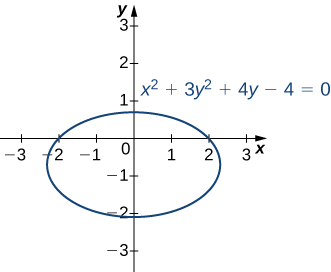Learning Objectives
- Perform implicit differentiation of a function of two or more variables.
Recall from Implicit Differentiation that implicit differentiation provides a method for finding [latex]dy/dx[/latex] when [latex]y[/latex] is defined implicitly as a function of [latex]x[/latex]. The method involves differentiating both sides of the equation defining the function with respect to [latex]x[/latex], then solving for [latex]dy/dx[/latex]. Partial derivatives provide an alternative to this method.
Consider the ellipse defined by the equation [latex]x^{2}+3y^{2}+4y-4=0[/latex] as follows.

Figure 1. Graph of the ellipse defined by [latex]x^{2}+3y^{2}+4y-4=0[/latex].
This equation implicitly defines [latex]y[/latex] as a function of [latex]x[/latex]. As such, we can find the derivative [latex]dy/dx[/latex] using the method of implicit differentiation:
[latex] \hspace{8cm} \begin{align} \frac{d}{dx}(x^2+3y^2+4y-4)&=\frac{d}{dx}(0) \\ 2x+6y\frac{dy}{dx}+4\frac{dy}{dx}&=0 \\ (6y+4)\frac{dy}{dx}&=-2x \\ \frac{dy}{dx}&=-\frac{x}{3y+2}. \end{align}[/latex]
We can also define a function [latex]z=f(x, y)[/latex] by using the left-hand side of the equation defining the ellipse. Then [latex]f(x, y)=x^{2}+3y^{2}+4y-4[/latex]. The ellipse [latex]x^{2}+3y^{2}+4y-4=0[/latex] can then be described by the equation [latex]f(x, y)=0[/latex]. Using this function and the following theorem gives us an alternative approach to calculating [latex]dy/dx[/latex].
Theorem: implicit differentiation of a function of two or more variables
Suppose the function [latex]z=f(x, y)[/latex] defines function [latex]y[/latex] implicitly as a function function [latex]y=g(x)[/latex] of [latex]x[/latex] via the equation [latex]z=f(x, y)=0[/latex]. Then
[latex]\large{\frac{dy}{dx}=-\frac{\partial f/\partial x}{\partial f/\partial y}}[/latex]
provided [latex]f_y(x, y)\neq 0[/latex].
If the equation [latex]z=f(x, y, z)=0[/latex] defines [latex]z[/latex] implicitly as a differentiable function of [latex]x[/latex] and [latex]y[/latex], then
[latex]\large{\frac{\partial z}{\partial x}=-\frac{\partial f/\partial x}{\partial f/\partial z}}[/latex] and [latex]\large{\frac{\partial z}{\partial y}=-\frac{\partial f/\partial y}{\partial f/\partial z}}[/latex]
as long as [latex]f_z(x, y, z)\neq 0[/latex].
The equation for Implicit Differentiation of a Function of Two or More Variables is a direct consequence of the Chain Rule for Two Independent Variables. In particular, if we assume that [latex]y[/latex] is defined implicitly as a function of [latex]x[/latex] via the equation [latex]f(x, y)=0[/latex], we can apply the chain rule to find [latex]dy/dx[/latex]:
[latex]\hspace{8cm} \begin{align} \frac{d}{dx}f(x,y)&=\frac{d}{dx}(0) \\ \frac{\partial f}{\partial x}\cdot\frac{dx}{dx}+\frac{\partial f}{\partial y}\cdot\frac{dy}{dx}&=0 \\ \frac{\partial f}{\partial x}+\frac{\partial f}{\partial y}\cdot\frac{dy}{dx}&=0. \end{align}[/latex]
Solving this equation for [latex]dy/dx[/latex] gives the Implicit Differentiation of a Function of Two or More Variables in terms of [latex]x[/latex]. The Implicit Differentiation of a Function of Two or More Variables in terms of [latex]x[/latex] and [latex]y[/latex] can be derived in a similar fashion.
Let’s now return to the problem that we started before the previous theorem. Using Implicit Differentiation of a Function of Two or More Variables and the function [latex]f(x, y)=x^{2}+3y^{2}+4y-4[/latex], we can obtain
[latex]\hspace{10cm} \begin{align} \frac{\partial f}{\partial x}&=2x \\ \frac{\partial f}{\partial y}&=6y+4. \end{align}[/latex]
Then the Implicit Differentiation of a Function of Two or More Variables in terms of [latex]x[/latex] gives
[latex]\large{\frac{dy}{dx}=-\frac{\partial f/\partial x}{\partial f/\partial y}=-\frac{2x}{6y+4}=-\frac{x}{3y+2}},[/latex]
which is the same result obtained by the earlier use of implicit differentiation.
Example: implicit differentiation by partial derivatives
a. Calculate [latex]dy/dx[/latex] if [latex]y[/latex] is implicitly as a function of [latex]x[/latex] via the equation [latex]3x^{2}-2xy+y^{2}+4x-6y-11=0[/latex]. What is the equation of the tangent line to the graph of this curve at point [latex](2, 1)[/latex]?
b. Calculate [latex]\partial z/\partial x[/latex] and [latex]\partial z/\partial y[/latex], given [latex]x^2e^y-yze^x=0[/latex].
try it
Find [latex]dy/dx[/latex] if [latex]y[/latex] is defined implicitly as a function of [latex]x[/latex] by the equation [latex]x^{2}+xy-y^{2}+7x-3y-26=0[/latex]. What is the equation of the tangent line to the graph of this curve at point [latex](3, -2)[/latex]?
Watch the following video to see the worked solution to the above Try It

